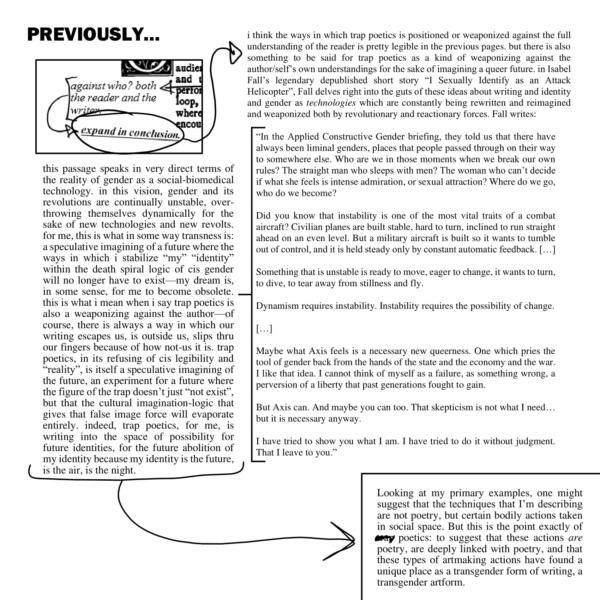“Trap Poetics” [Part 1] [Part 2] [Part 3] [Part 4]

Accessibility Text
This page consists of a more linear text, with a few visual elements which will be described.
PREVIOUSLY…
There is an image which shows a detail from page one, reading: “against who? Both the reader and the writer.” In the image, an arrow points from this passage, to a note which reads “expand in conclusion.”
The phrase “expand in conclusion” has a new circle drawn around it, with an arrow pointing to a passage outside the borders of the image of the detail of page 1. This passage reads: “I think the ways in which trap poetics is positioned or weaponized against the full understanding of the reader is pretty legible in the previous pages. But there is also something to be said for trap poetics as a kind of weaponizing against the author/self’s own understandings for the sake of imagining a queer future. In Isabel Fall’s legendary depublished short story, “I Sexually Identify as an Attack Helicopter”, Fall delves right into the guts of these ideas about writing and identity and gender as technologies which are constantly being rewritten and reimagined and weaponized both by revolutionary and reactionary forces. Fall writes:”
““In the Applied Constructive Gender briefing, they told us that there have always been liminal genders, places that people passed through on their way to somewhere else. Who are we in those moments when we break our own rules? The straight man who sleeps with men? The woman who can’t decide if what she feels is intense admiration, or sexual attraction? Where do we go, who do we become?
Did you know that instability is one of the most vital traits of a combat aircraft? Civilian planes are built stable, hard to turn, inclined to run straight ahead on an even level. But a military aircraft is built so it wants to tumble out of control, and it is held steady only by constant automatic feedback. […]
Something that is unstable is ready to move, eager to change, it wants to turn, to dive, to tear away from stillness and fly.
Dynamism requires instability. Instability requires the possibility of change.
[…]
Maybe what Axis feels is a necessary new queerness. One which pries the tool of gender back from the hands of the state and the economy and the war. I like that idea. I cannot think of myself as a failure, as something wrong, a perversion of a liberty that past generations fought to gain.
But Axis can. And maybe you can too. That skepticism is not what I need… but it is necessary anyway.
I have tried to show you what I am. I have tried to do it without judgment. That I leave to you.”
A bracket around is around this quote and points to another passage. This passage reads: “This passage speaks in a very direct terms of the reality of gender as a social-biomedical technology. In this vision, gender and its revolutions are continually unstable, overthrowing themselves dynamically for the sake of new technologies and new revolts. For me, this is what in some way transness is: a speculative imagining of a future where the ways in which I stabilize “my” “identity” within the death spiral logic of cis gender will no longer have to exist—my dream is, in some sense, for me to become obsolete. This is what I mean when I say trap poetics is also a weaponizing against the author—of course, there is always a way in which our writing escapes us, is outside us, slips through our fingers because of how not-us it is. Trap poetics, in its refusing of cis legibility and “reality”, is itself a speculative imagining of the future, an experiment for a future where the figure of the trap doesn’t just “not exist”, but that the cultural imagining-logic that gives that false image force will evaporate entirely. Indeed, trap poetics, for me, is writing into the space of possibility for future identities, for the future abolition of my identity because my identity is the future, is the air, is the night.”
A bracket is around this passage, with an arrow pointing to a final passage within a box. This passage reads: “Looking at my primary examples, one might suggest that the techniques I’m describing are not poetry, but certain bodily actions take in social space. But this is the point exactly of [word crossed out] poetics: to suggest that these actions are poetry, are deeply linked with poetry, and that these types of artmaking actions have found a unique place as a transgender form of writing, a transgender artform.
Originally from Oxford, Ohio, Ava Hofmann is a trans writer currently living and working in Baton Rouge, Louisiana. She has poems published in or forthcoming from Black Warrior Review, Fence, Anomaly, Best American Experimental Writing 2020, The Fanzine, Datableed, Peachmag, Always Crashing, Foglifter, and Petrichor. Her poetry deals with trans/queer identity, Marxism, and the frustrated desire inherent to encounters with the archive. Her chapbook, THE WOMAN FACTORY is forthcoming from The Operating System. Her website is www.nothnx.com and her twitter is @st_somatic